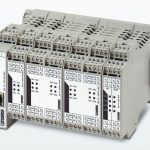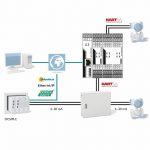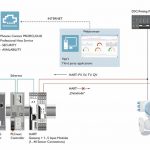Firmen im Artikel
The process industry is confronted with the same challenges as any other industrial sector: to reduce operating costs and increase system availability. This can be achieved, for example, by providing additional diagnostic data. Monitoring equipment health can improve overall equipment effectiveness (OEE) and be part of a predictive maintenance strategy that brings down operating costs. If calibration and configuration activities can also be carried out remotely, this saves the time needed for the employee concerned to travel to the site and furthermore has benefits for safety. In many cases, the additional data which is required can be supplied by existing devices. Around 40 million Hart devices are installed worldwide, with 90 % of users only interested in the 4…20 mA analogue signal rather than the configuration, calibration and plant management functions. If access to this unused data were to be retrofitted, an estimated 20 % of the devices could provide valuable information.
The Hart protocol was standardised almost 30 years ago and is today the most popular communication standard in the global process industry. Hart originally aimed to make analogue process measuring devices smarter by superimposing digital data on a 4…20 mA signal loop. The standard has evolved over the years due to the introduction of additional transmission methods such as data communication via Ethernet or wireless. The backward compatibility of the technology and the interoperability of devices from different manufacturers ensure that users are not restricted to vendor-specific or purely regional solutions.
Capabilities of Hart devices
The Hart protocol thus offers numerous possibilities, though unfortunately many users are still unaware of them. Often, a DCS or PLC is in place or specified without Hart capabilities. As a result, the control system does not use the additional measurement and diagnostic data provided by Hart devices. Only maintenance personnel employ the Hart interface for local troubleshooting or calibration with a handheld device. Knowledge about the capabilities of Hart devices is therefore lost. Their advantages are summarised again here for this reason:
- Configuration: In the simplest scenario, the devices can be configured using the Hart protocol. Preconfigured setups ease selection of operating parameters such as the measurement range, engineering units and sensor type.
- Calibration: After initial installation and configuration, the device can be calibrated by setting the zero and span, trimming the 4…20 mA signal or taking external sources of measurement errors into account.
- Diagnostics: Hart devices are rich in terms of diagnostic data. Many of them can monitor the condition of a sensor or probe, indicating inaccurate measurements at an early stage. They can also detect configuration errors or operating modes that may lead to problems in the future. Most importantly, however, diagnostic data can be used to determine the health of a large item of equipment or the quality and efficiency of processes. This helps to avoid unplanned maintenance.
- Multivariable devices: Most Hart devices are multivariable, meaning that they can provide multiple measurement values. Only the primary value is represented by the 4…20 mA signal, while the other variables are merely available as digital data. Pressure transmitters can, for example, provide the absolute or gauge process pressure as well as the ambient temperature. Temperature transmitters may also supply the process and ambient temperatures as well as cold junction compensation values. Differential pressure transmitters indicate static pressure and ambient temperature in addition to differential pressure. Coriolis meters deliver information like mass flow, density and temperature. Last but not least, valve positioners report data such as the target and actual positions of the valve stem to the actuator as well as the actuator pressure and the output signal.
Overcoming missing serial interfaces
In the past, if a plant operator decided to upgrade the control system and wanted to access the Hart data, an RS485 Hart multiplexer was usually installed and connected to a PC. However, most PCs do not have an RS485 interface, so an RS232 converter was used. Currently, PCs tend not even to have an RS232 interface any more, so that a device server for conversion from RS485 to Ethernet has to be purchased. This is liable to be a complicated solution with several devices to configure and maintain.
The Hart Foundation, which is now part of the Fieldcomm Group, recently published a standard for Hart IP, which essentially describes the Hart protocol over Ethernet as a convenient and generally available interface for communication using the Hart protocol. It supports the integration of tools that most plant operators already resort to: Pactware (or another FDT container), Hart Server, Hart OPC Server, Simatic PDM and Honeywell FDM. Hart IP thus also takes account of two mega trends – Industry 4.0 and the Industrial Internet of Things (IIoT) – which require Ethernet-based data communication and high network connectivity.
Converting Hart data
The modular Ethernet Hart multiplexer GW PL…. Bus from Phoenix Contact offers the option of parameterising and monitoring Hart devices via Ethernet. They can be easily integrated into almost any host system via an industrial Ethernet system such as Profinet, Modbus TCP or Hart IP; the analogue control system remains fully operational and does not even have to be shut down for installation.
The Ethernet Hart multiplexer consists of a head station and a series of four- or eight-channel Hart expansion modules, enabling any user requirements to be implemented. Up to five expansion modules can be connected to the head station and supplied with power from it for a maximum of
40 Hart devices. The modular design therefore permits a scalable solution for modern distributed control systems as well as phased roll-outs. The multiplexer converts the Hart data to Hart IP, so that the corresponding devices can communicate with many host applications such as those mentioned above. In combination with Simatic PDM, which provides Hart access via Hart Server, the GW PL system also supports asset management via EDD (Electronic Device Description).
The Ethernet Hart multiplexer was additionally tested for compatibility and approved by Emerson for use with their own AMS package. If several Ethernet protocols are installed, users with Hart IP can access the diagnostic data via AMS or a technology station while the process data is simultaneously transmitted to a process control system via Modbus TCP or Profinet. I/O points on the controller are freed up in this way, for example, and the secondary variables of a Hart device can be accessed easily.
Online search: cpp0318phoenixcontact
Author: Garrett Schmidt
Product Manager Communication Interfaces,
Phoenix Contact USA











